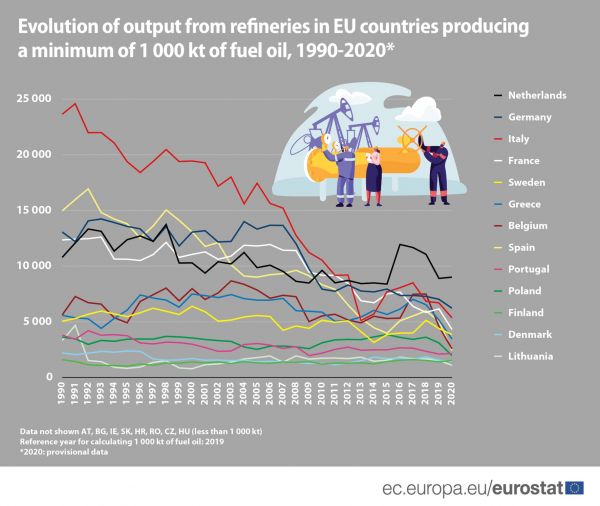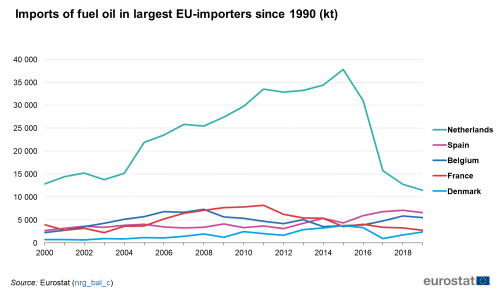Heavy fuel oil - production, trade and use
Data extracted in September 2021
No planned update
Highlights
In 2019, 5 EU Member States accounted for nearly 75% of intra and extra EU imports of fuel oil.
Most fuel oil in the EU is used to power ships engaged in international navigation; in 2019 this amounted to 35 000 kt.
This article gives an overview of a specific oil product known as fuel oil. Due to its weight it is also addressed as heavy fuel oil. Energy statistics on this product are available for all 27 EU Member States for the period 1990 to 2019.
The refinery processes split crude oil into a light fraction (diesel, naphtha and petrol) and heavy residues (fuel oil and bitumen). Due to its viscosity and sulphur content, fuel oil is difficult to use and refineries generally try to reduce its production. Most ships are using fuel oil, and most of the sulphur contained in fuel oil ends up in the atmosphere when combusted in the ship’s engine (source : IMO). Due to growing concerns over the environmental impact, more ambitious efforts to limit pollution from ship transport are on envisaged (see at the end of this article).
Authors: Audrey Errard, Cristina Martello and Michael Goll
Full article
What is fuel oil ?
Fuel oil covers all residual fuel oils, including those obtained by blending. It is divided into two categories depending on its sulphur content:
- "low sulphur fuel oil" where the sulphur content is lower than 1 %.
- "high sulphur fuel oil" where the sulphur content is 1 % m/m or higher.
Fuel oil production has decreased over the last thirty years
The production of fuel oil has decreased over the last decades (see Figure 1). In 2020, 21 Member States were still producing fuel oil, of which thirteen produced more than 1 000 kt (see Figure 1). Luxembourg, Latvia, Malta and Estonia have never had any refineries, while Cyprus stopped producing fuel oil in 2004, and Slovenia in 2000. Changed processing techniques in refineries limited the production of fuel oils during the last decades. This means that the percentage (weight) of fuel oil per ton of crude oil intake in refineries diminished.
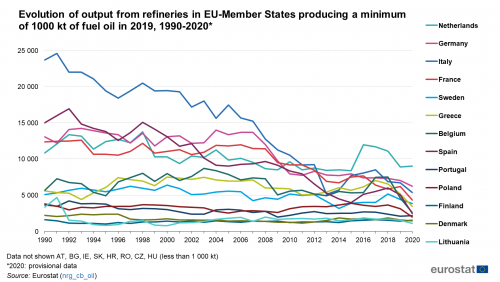
Source: Eurostat (nrg_cb_oil)
The most significant decreases in output over the 1990-2020 period were observed in Italy and Spain. Italy was the main producer in the EU until 2011. Nowadays, the Netherlands is the main producer with 9 000 kt in 2020. In 1990, Italy produced 24 000 kt compared with 5 400 kt in 2020. Spain produced just under 15 000 kt in 1990 and 2 400 in 2020. In 2020, five Member States accounted for about 60 % of the fuel oil production in the EU, namely the Netherlands (19 % with 9 000 kt), Germany (13 % with 6 200 kt), Italy (11 % with 5 400 kt), France (9 % with 4 400 kt) and Sweden (8 % with 3 900 kt).
In seven countries, high sulphur fuel oil (> 1 % sulphur) represents more than 50 % of total fuel oil production (Figure 2).
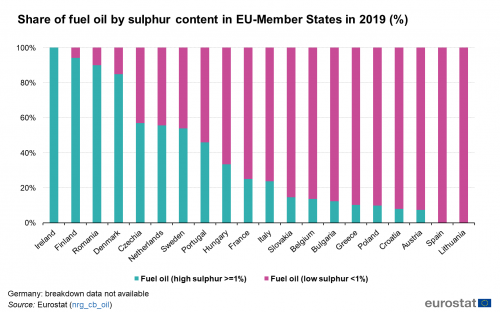
Source: Eurostat (nrg_cb_oil)
The production of fuel oil (as a proportion of the amount of crude oil refinery intake) varies in the Member States, with a maximum of 29 % for Ireland and a minimum of 1 % for Romania in 2020 (see Figure 3). These figures can be partially explained by the fact that each refinery is “tuned” to the crude oil type it treats (crude oil quality changes depending on the source country and field), and can be very specialised (e.g. for kerosene). Many Member States have only one refinery, while some, the Netherlands for example, have several refineries with different specialisations.
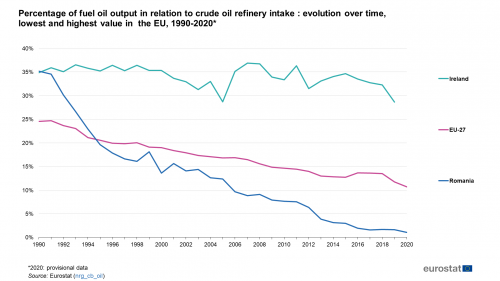
Source: Eurostat (nrg_cb_oil)
Trade of fuel oil in the EU and with third countries
Intra EU fuel oil trade (imports and exports each around 25 000 kt), is bigger in volume than extra EU trade (imports 15 000 kt, exports 20 000 kt). In 2019, EU Member States imported about 40 000 kt of fuel oil, of which almost 25 000 kt were coming from other EU countries and around 15 000 kt were imported from countries outside the EU (40.4 % from Russia, 16.3 % from the United Kingdom and 11.5 % from Norway). In 2019, Member States exported about 45 000 kt of which 25 000 kt were sent to other EU countries and 20 000 kt were exported to countries outside the EU (19.8 % to the US, 16.7 % to the United Kingdom and 16.6 % to Saudi Arabia ; see Figure 4).

Source: Eurostat (nrg_bal_c)
Five Member States accounted for nearly 75 % of the imports of the EU, namely the Netherlands (29 % with 11 500 kt), Spain (17 % with, 6 600 kt), Belgium (14 % with 5 500 kt), France (7 % with 2 800 kt) and Denmark (6 % with 2400 kt) (see Figure 5).
Five Member States accounted for 55 % of total EU exports including intra EU trade, namely the Netherlands (22 % with 9 500 kt), Belgium (9 % with 4 100 kt), France (8 % with 3 700 kt), Italy (8 % with 3 600 kt) and Sweden (7 % wih 3 100 kt) (see Figure 6).
As previously mentioned, production in Italy, France and Germany (Figure 1) has decreased continuously over the last decades but has remained stable in the Netherlands. In contrast, imports and exports drastically decreased in the Netherlands since 2015, while trade in the other EU countries changed to a lesser extent (see Figures 1, 4, 5 and 6).
Use of fuel oil in the EU
Fuel oil is either used in industry (3 450 kt in 2019) for processing heat generation etc. but also in the transformation sector (5 700 kt in 2019 for power plants) to generate electricity and heat and in the transport sector for domestic navigation (coastal shipping, inland waterways etc.; 1 500 kt in 2019).
However, by far the biggest amount of fuel oil is used to power ships engaged in international navigation (international shipping). Fuel oil used for this purpose is stored in international maritime bunkers and amounted to 35 000 kt in 2019.
Figure 7 shows that since 2006, fuel oil is mainly used in international navigation.
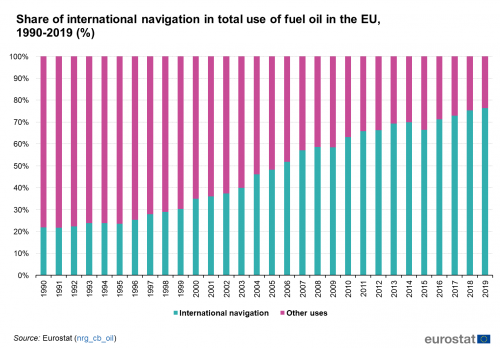
Source: Eurostat (nrg_cb_oil)
In 2019, fuel oil was used mainly for international navigation, and in some countries almost exclusively, such as Slovenia, the Netherlands, Malta and Belgium, and in many of the countries bordering the Baltic sea, such as Latvia, Lithuania (both over 90 %), Denmark, Sweden (both over 80 %), and to a lesser extent Estonia (74 %), Finland, Poland and Germany (25-50 %) (see Figure 8).

Source: Eurostat (nrg_cb_oil)
Not all Member States used fuel oil in equal amounts. In 2019, five Member States accounted for over 75 % of the fuel oil used for international navigation in the EU, namely the Netherlands (27 % with 9 200 kt), Belgium (21 % with 7 000 kt), Spain (16 % with 5 500 kt), Greece and Italy (6 % with 2 100 kt each) (see Figure 9).
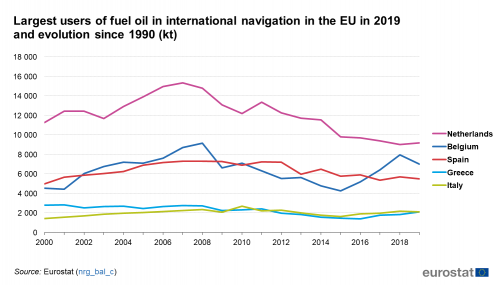
Source: Eurostat (nrg_bal_c)
Due to growing concerns over the environmental impact of pollution due to the use of fuel oil, the International Maritime Organization of the United Nations (IMO) organised the International Convention for the Prevention of Pollution from Ships (MARPOL) in the 1970s. In 1997, the MARPOL Protocol was adopted to amend the Convention and one of its annexes limits the sulphur content in fuel oil used for navigation/shipping. Decisions taken at international level (UN) are always transposed to EU law. As a consequence, in the EU, the sulphur content in fuel oil is regulated to limit marine pollution from ships. This means that ships must use fuel oil with a limited sulphur content to prevent the emission of ozone-depleting substances, such as sulphur oxides (SOx) (Directive (EU) 2016/802 of the European Parliament and of the Council). This limit has been revised several times over the last decades.
Since their introduction in 2015, the regulations to lower sulphur oxide (SOx) emissions at sea seemed to have a certain but rather limited impact on the trade and the production of fuel oil. However, the amount of fuel oil used in international navigation has remained more or less constant in the EU during the last twenty years. Apart from the Netherlands, since 2015 no clear reduction regarding the use of fuel oil in international navigation in the EU is visible. Nowadays, most of the fuel oil produced in the EU is used for international navigation to satisfy the increased need for this transport fuel which has grown in the last years due to increased international trade e.g. with Southeast Asia.
On 1 January 2020, “IMO 2020” came into force. The goal is to pursue efforts in improving air quality, preserving the environment and protecting human health.
- Outside of Emission Control Areas (ECAS), the sulphur content in the fuel oil used by ships is set to 0.5 % m/m at the most.
- Inside of ECAS the limit is set to 0.10 % m/m as a maximum.
The four ECAS are: the Baltic Sea area, the North Sea area, the North American area, and the United States Caribbean Sea area. Given the new limit (0.5 % m/m outside ECAS, 0.1 % inside ECAS), it is expected that this will affect the production and the use of fuel oil in the future in Members States further.
Source data for tables and graphs
Data sources
Energy statistics are available for all 27 Member States. Data are available for the period 1990 to 2019 (nrg_bal_c) and 2020 (nrg_cb_oil; provisional data) and are based on the annual oil questionnaire.
Context
The Energy statistics Regulation (EC) No 1099/2008 is the legal basis for the reporting of annual energy questionnaires.
Direct access to
- Energy Statistics - main indicators (t_nrg_indic)
- Final energy consumption by product (ten00123)
- Energy statistics - quantities (nrg_quant)
- Energy statistics - quantities, annual data (nrg_quanta)
- Supply, transformation and consumption of oil and petroleum products (nrg_cb_oil)
- Energy statistics - quantities, annual data (nrg_quanta)
- Energy balances (nrg_bal)
- Complete energy balances (nrg_bal_c)
Visualisations
- Supply, transformation and consumption - commodity balances (annual) - ESMS metadata file (nrg_cb_esms)
- Energy statistics - supply, transformation, consumption (monthly) - ESMS metadata file (nrg_10m_esms)
The proportions of the use of fuel oil were calculated based on the sum of Gross Inland Deliveries observed (referred to here as “Other uses” in Figures 7 and 8) and International Maritime Bunkers (referred to here as “International navigation” in Figures 7 and 8). Gross Inland Deliveries observed refers to the amounts of fuel oil used inland (in Member States).
Observed gross inland deliveries = Fuel oil used inside the boundaries of a given country in the transformation-, energy-, transport-, industry- and other sectors.
- Regulation (EC) No 1099/2008 of 22 October 2008 on energy statistics
- EUROPE 2020: A strategy for smart, sustainable and inclusive growth
- Summaries of EU legislation: Europe 2020: the European Union strategy for growth and employment
- Summaries of EU legislation: Common system for the production of energy statistics
External links
